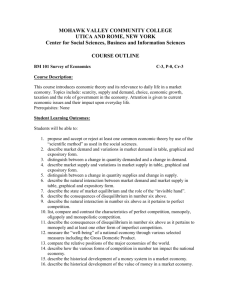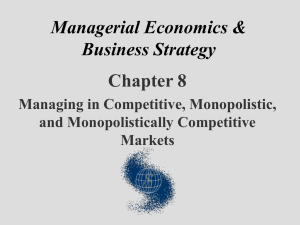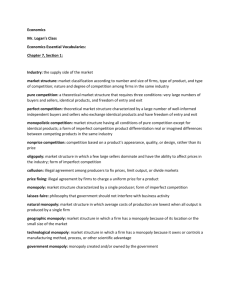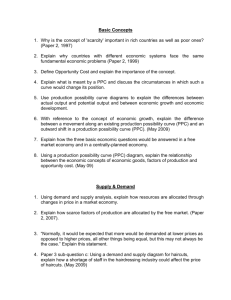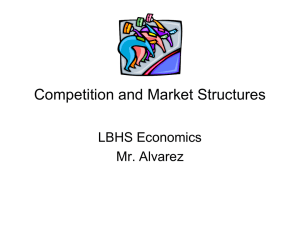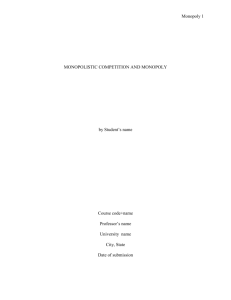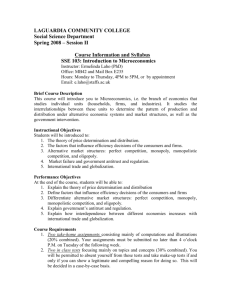Lecture 12: Monopolistic Competition
advertisement
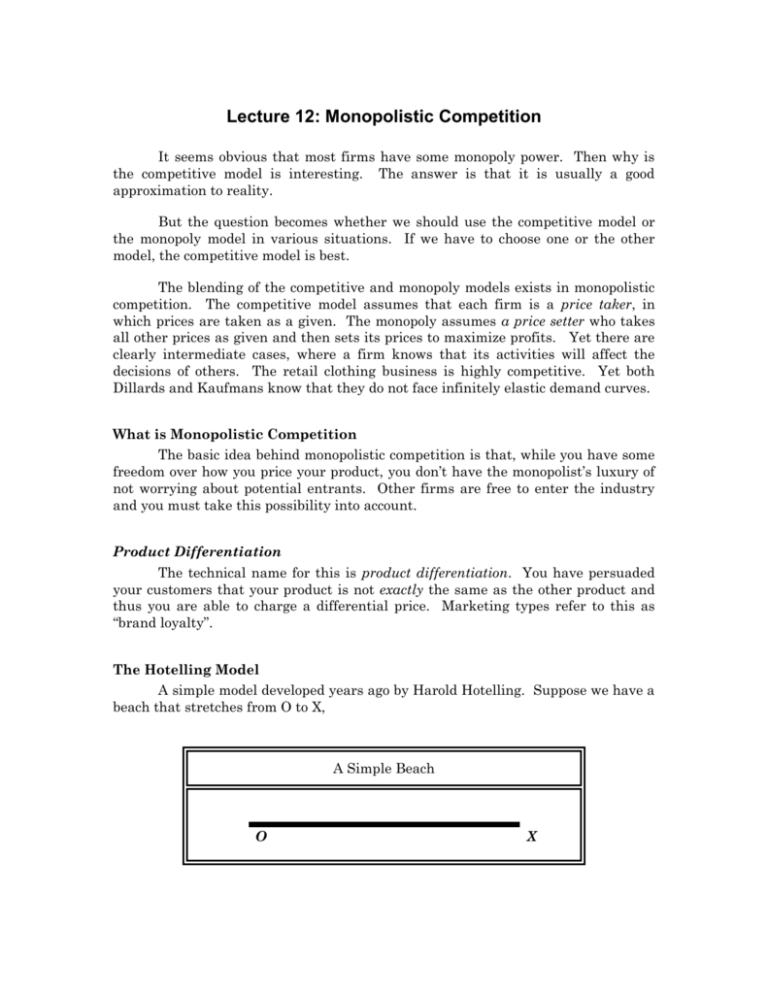
Lecture 12: Monopolistic Competition It seems obvious that most firms have some monopoly power. Then why is the competitive model is interesting. The answer is that it is usually a good approximation to reality. But the question becomes whether we should use the competitive model or the monopoly model in various situations. If we have to choose one or the other model, the competitive model is best. The blending of the competitive and monopoly models exists in monopolistic competition. The competitive model assumes that each firm is a price taker, in which prices are taken as a given. The monopoly assumes a price setter who takes all other prices as given and then sets its prices to maximize profits. Yet there are clearly intermediate cases, where a firm knows that its activities will affect the decisions of others. The retail clothing business is highly competitive. Yet both Dillards and Kaufmans know that they do not face infinitely elastic demand curves. What is Monopolistic Competition The basic idea behind monopolistic competition is that, while you have some freedom over how you price your product, you don’t have the monopolist’s luxury of not worrying about potential entrants. Other firms are free to enter the industry and you must take this possibility into account. Product Differentiation The technical name for this is product differentiation. You have persuaded your customers that your product is not exactly the same as the other product and thus you are able to charge a differential price. Marketing types refer to this as “brand loyalty”. The Hotelling Model A simple model developed years ago by Harold Hotelling. Suppose we have a beach that stretches from O to X, A Simple Beach O X Bathers are scattered uniformly along the beach. There are two ice cream vendors who for simplicity are required to charge the same price for their identical ice cream cones. Where should the vendors locate their stands? The obvious social objective is to minimize the average travel time for customers, which will happen if they locate at 0.25X and 0.75X. Rational consumers will go to the nearest vendor; thus each vendor would have half the market and will be located at the middle of their market. The average distance from customer to vendor will be 0.125X each way. Other locations will increase average travel time. For example, if they both locate at 0.5X. Average travel time will be 0.25X. Yet, in the absence of regulation, that is exactly where they will locate. If one vendor stays at 0.25x, it pays for the second vendor to locate at (0.25 + )X and capture 3/4 of the market. Thus both vendors go to the center of the beach. An Aside: Political Implications This model was developed to explain why spatial competition could lead to economic inefficiencies. It also has another advantage, it explains why political parties tend to locate at the center. We never find a political candidate or party - at least a viable one - whose views are totally sound (i.e., in complete agreement with our own views). Thus we end up voting for the political party or the candidate whose views are closest to our own. Thus if there are two political parties competing for votes, they will tend to adopt the views of the median voter. The “tweedle dee” or “tweedle dum” choice is rational behavior by politicians. A call for a “choice, not an echo” is a call to lose an election. Some Other Extensions You will note some difficulties in the model; firms cannot set their own prices nor can entry occur nor can new technology, wandering ice cream salesmen, be developed. But this model provides a basis for our theory of monopolistic competition. There is one important element of reality in the model. Individuals are assumed to choose their vendor on the basis of “closeness”, thus minimizing their travel costs. You will go to the firm with the lowest full price, but that gives an edge - and some monopoly power over you - to the firm closest to you. Attribute Space The model can also be extended to the choice of consumers choosing between different attributes. Consider that consumers "a" through "p" are assumed to have different preferences between tartness and caffeine content for a particular type of soda. There are two brands currently available, X and Y. Consumers choose between the two brands according to which is closer to their ideal preferences. Thus "m" is almost certainly going to choose Y while "d" looks like some one who will stick with X. Marketing gurus get big bucks for reproducing this same graph and talking about "brand loyalty", "brand positioning", "attribute spaces", "preference metrics" and the like. What it means, quite simply is that X and Y both have monopoly power. They can raise their prices without fear of losing their core customers to the other brand. If X charges a significantly greater amount that Y, he will lose even "d" as a captive customer. But now price is not the only attribute and that gives both some power to raise prices without losing all of their customers. At the same time, they compete viciously. Marketing Research in One Easy Graph Consumers have different preferences for soft drinks according to the amount of caffeine and tartness. While we talk about prices, this graph also has significant implications for brand positioning and the like. It also applies in the choice of many similar commodities. Imagine consumers of automobiles. Some prefer big cars, while others prefer small cars. We can then think of consumers being “located” on a spectrum of preferences. As a practical matter, you can never find an automobile that is exactly the size or quality you desire; instead you will probably be forced to choose the car that is “closest” in size and quality to your preferences. A Final Example For a final example of monopoly power by location, suppose there are two stores selling ice cream cones. They both stock Ben and Jerry’s butter pecan, your favorite flavor. The difference is in terms of location and the size of the cone. Choices for Ice Cream Store Time to and from the store Size of Cone Price A B 10 minutes 20 minutes 1 scoop 2 scoops $1.25 $1.50 Two other facts: your wage rate is $6 an hour, and, the extra benefit of the second scoop to you is 40 cents. What then is the full cost of the two cones? Adjusting for travel time, we would say that the full cost of A’s cone is $2.25, while the cost of B’s cone is $3.50, so that the difference in full price is $1.25. However the extra scoop is worth 40 cents to you, so the difference in full price, adjusted for quality, is $0.85. Generalizations The key points are quite clear: Each vendor has monopoly power because of its location and thus can charge monopoly prices. There is non-price competition, because of location, and thus vendors “position” themselves differently in the market. At the same time. Entry of new vendors takes place until the net profits of each vendor, monopoly power and all is zero. A Second Example of Monopolistic Competition College textbook markets provide another example of monopolistic competition. This example is inspired by complaints about the high prices of textbooks. Why is the price so high? The naive answer is that the price is high because of all the work the publishers do on the book. There are color drawings, beautiful typography, etc. But that misses the point. The instructor, not the student picks the book, and yet he does not pay for it. Thus his decision is based on the book and not on price. This is not to say that there is zero price elasticity of demand. After all, the price gets added to the course, and there is some elasticity of demand for the course. Of course, the course is not a marginal cost, after all, for the college and program of study has already been chosen, so the overall elasticity is zero. Students do have choices of sharing textbooks, going naked (without a textbook), or (the dreaded fear of all publishers) going to the second hand market. So there is some elasticity of demand. The non-price competition includes Salesmen to call on professors, and complimentary textbooks for professors. Slick glossy textbooks, of high quality. Efforts to write different textbooks to appeal to different professors. In some cases, (I have heard and hope to experience at some point) bribes, disguised and not, to professors to adopt textbooks. The key point to note is the direction of causation. It is not, as some people imply High Costs High Prices but rather that Low Price Elasticity of Demand High Monopoly Prices Non Price Competition High Costs

